|
Click any typewriter
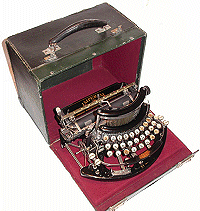
Imperial B - 1915
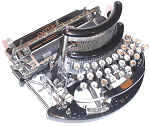
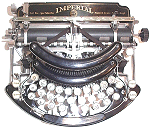

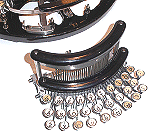
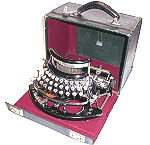


|
Some time before 1901, a
Spanish-American engineer, Hildalgo Moya, came to Britain. In his luggage
Moya brought plans for an innovative portable typewriter.
Moya was born in St Louis, Missouri, in 1863 and is said to have worked for
the Hammond Typewriter Company. The purpose of his journey to England
was to become manager of the Remington Typewriter Company's UK office but
Moya's dream was to start his own typewriter company and to make and sell
his own machine for the very low price of 5 guineas. Moya settled in
Leicester. There he found a local businessman, John Gordon Chattaway, willing to
finance his machine and he set up a small factory in Garton Street Leicester
on what is now the site of the Leicester Royal Infirmary. Moya also
found a wife, since he subsequently married Chattaway's daughter, Sophia.
The Moya Typewriter of 1902 uses a rubber type sleeve and bears more
than a passing resemblance to the successful Blickensderfer 5, but was not
completely visible. A new version, produced in 1905, the Moya Visible
moved the ribbon spools to the sides to improve visibility, but neither
machine was commercially successful and the 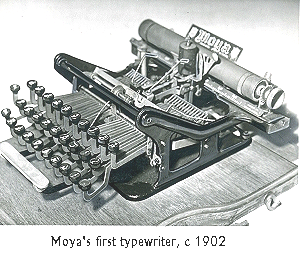 Moya Typewriter Company
foundered. Fresh finance was needed and,
together with two local businessmen, W. Evans and J.W. Goddard, Moya founded the Imperial Typewriter
Company in 1908. For the new venture,
Moya dropped his original idea and instead designed an even more innovative typewriter, the Imperial A, a
physically small downstrike machine with a curved keyboard similar to that
of the first Hammond machines of 1884. However, the most innovative part of
Moya's
design was that the keyboard and typebasket of the machine could be unscrewed and removed in a
minute or two, and be replaced with another typeface. This enabled the
Imperial A to compete with replaceable type shuttle or type sleeve
machines such as the Hammond and the Blickensderfer. Though physically
small, the model A with its cast iron base was far from portable, weighing 15 pounds without
case. In 1915, the model A was replaced by
the slightly more sophisticated model B shown here. Around the same time,
Moya began to experiment with casting the frame in aluminium to make the
machine more portable. Some Model
Bs - including the one
pictured here - were made in aluminium and provided with a leather carrying
case. This machine weighs about 9 pounds (about the same as the Underwood
Portable of 1919). A magazine article published in 'Typewriter Topics' in
January 1916, probably written by Moya, speaks of plans to Moya Typewriter Company
foundered. Fresh finance was needed and,
together with two local businessmen, W. Evans and J.W. Goddard, Moya founded the Imperial Typewriter
Company in 1908. For the new venture,
Moya dropped his original idea and instead designed an even more innovative typewriter, the Imperial A, a
physically small downstrike machine with a curved keyboard similar to that
of the first Hammond machines of 1884. However, the most innovative part of
Moya's
design was that the keyboard and typebasket of the machine could be unscrewed and removed in a
minute or two, and be replaced with another typeface. This enabled the
Imperial A to compete with replaceable type shuttle or type sleeve
machines such as the Hammond and the Blickensderfer. Though physically
small, the model A with its cast iron base was far from portable, weighing 15 pounds without
case. In 1915, the model A was replaced by
the slightly more sophisticated model B shown here. Around the same time,
Moya began to experiment with casting the frame in aluminium to make the
machine more portable. Some Model
Bs - including the one
pictured here - were made in aluminium and provided with a leather carrying
case. This machine weighs about 9 pounds (about the same as the Underwood
Portable of 1919). A magazine article published in 'Typewriter Topics' in
January 1916, probably written by Moya, speaks of plans to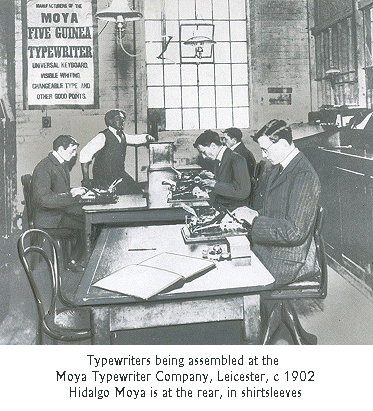 manufacture the Imperial C as the aluminium version of the
B in the Spring of 1916, and at least one magazine advertisement for the C
appeared in print at this time. However no machine marked in this
way has so far been found. It is reported that typewriter manufacturing
ceased at Imperial during the remainder of the First World War and did not
resume until 1919, so it appears that plans to manufacture the Model C were
shelved . When typewriter production resumed in
1919, a new model was introduced -- a straight keyboard version of
the portable B, usually referred to as Model D, although it is marked Imperial
Standard. In practice it is doubtful if the
removable keyboard idea played a major part in market acceptance of the Imperial
B, but there is no doubt that this little
machine successfully laid the foundations of the Imperial Typewriter Company over the next six
decades and the same principle was carried over when Imperial started to
manufacture desk machines in 1927 with its Model 50, which offered
interchangeable
platens, carriages and typefaces. Around 1928, the company began to
collaborate with German manufacturer Torpedo who had also introduced
interchangeability in its desk machines. One fruit of this
collaboration was the Regent machine which eventually Imperial bought out
entirely and re-christened 'The Good Companion' which remained in production in
different forms until 1963. To read the story of The Good Companion click
here. Like other typewriter manufacturers, Imperial
began to struggle in the 1960s against cheaper far east imports and in the
1964
the company was taken over by US electronics giant Litton Industries,
which also swallowed up Royal Typewriters, and after a brief revival, the Imperial name
disappeared completely. manufacture the Imperial C as the aluminium version of the
B in the Spring of 1916, and at least one magazine advertisement for the C
appeared in print at this time. However no machine marked in this
way has so far been found. It is reported that typewriter manufacturing
ceased at Imperial during the remainder of the First World War and did not
resume until 1919, so it appears that plans to manufacture the Model C were
shelved . When typewriter production resumed in
1919, a new model was introduced -- a straight keyboard version of
the portable B, usually referred to as Model D, although it is marked Imperial
Standard. In practice it is doubtful if the
removable keyboard idea played a major part in market acceptance of the Imperial
B, but there is no doubt that this little
machine successfully laid the foundations of the Imperial Typewriter Company over the next six
decades and the same principle was carried over when Imperial started to
manufacture desk machines in 1927 with its Model 50, which offered
interchangeable
platens, carriages and typefaces. Around 1928, the company began to
collaborate with German manufacturer Torpedo who had also introduced
interchangeability in its desk machines. One fruit of this
collaboration was the Regent machine which eventually Imperial bought out
entirely and re-christened 'The Good Companion' which remained in production in
different forms until 1963. To read the story of The Good Companion click
here. Like other typewriter manufacturers, Imperial
began to struggle in the 1960s against cheaper far east imports and in the
1964
the company was taken over by US electronics giant Litton Industries,
which also swallowed up Royal Typewriters, and after a brief revival, the Imperial name
disappeared completely.
The Portable Typewriter Website
Copyright © Richard Milton 2003-2004
Photographs by Courtesy of The Leicester Mercury
|
